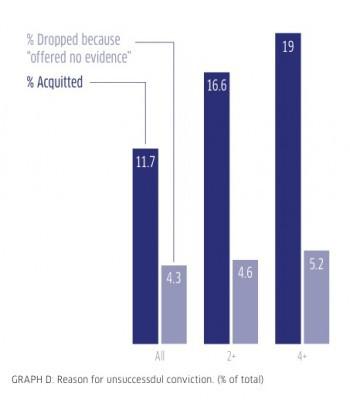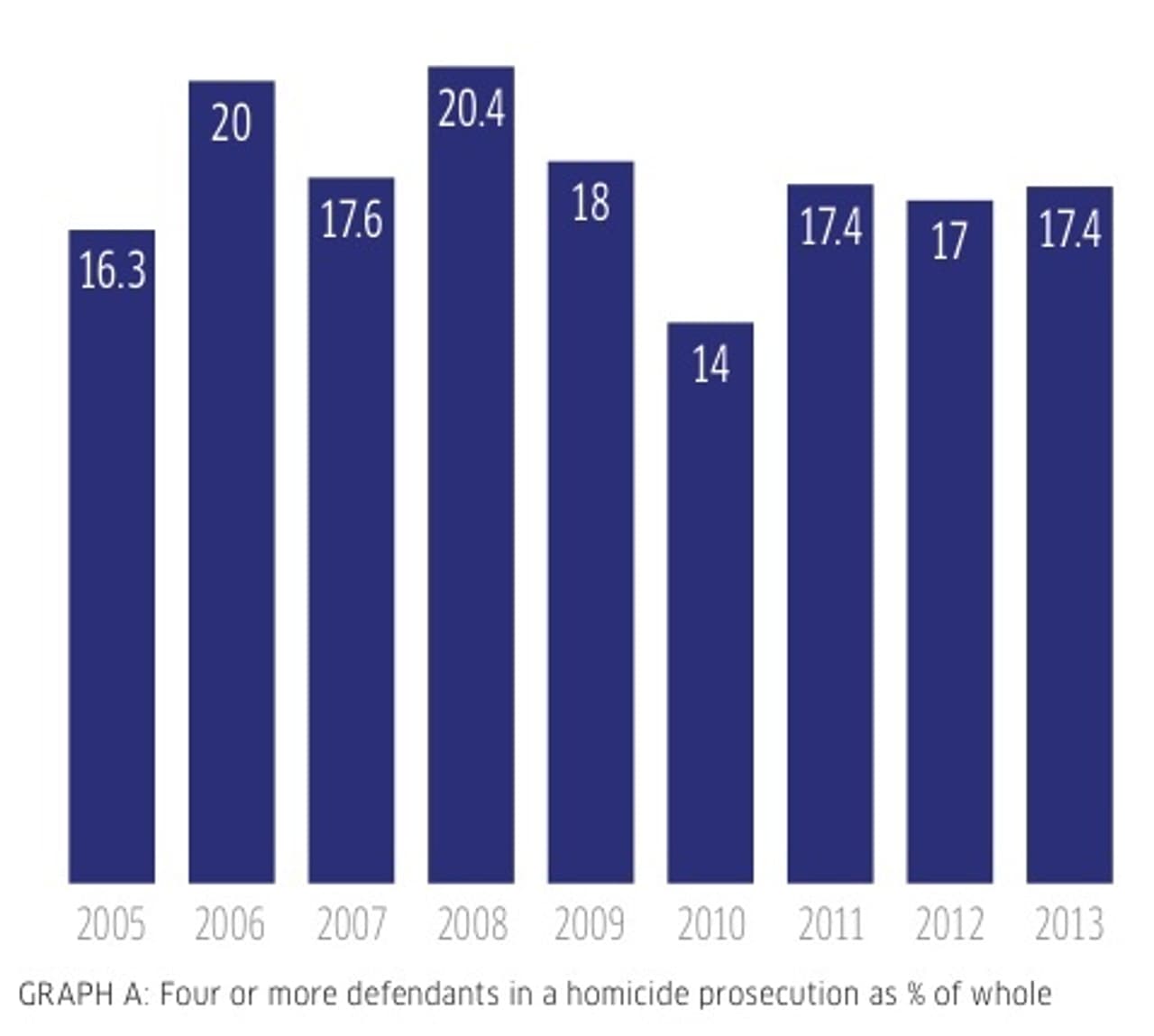
Data: joint enterprise in numbers
The Home Office, Ministry of Justice and CPS record a wealth of information about crimes and the perpetrators of those crimes. However, much to some legal experts’ dismay, there is no check box to record when a crime is prosecuted under joint enterprise.
Faced with a distinct lack of statistics, the Bureau set out to explore the figures that do exist and, using a series of Freedom of Information requests, collected data that indicated a likely use of joint enterprise.
We found:
- Between 2005 and 2013, 1,853 people were prosecuted by the CPS for homicides that involved four or more defendants. This is the closest approximation that can be made to the use of joint enterprise. Most academics agree these prosecutions almost certainly relied on the joint enterprise doctrine.
- In the same eight years 4,590 people were prosecuted for homicides involving two or more defendants – a definition the CPS suggests is a clear indication of the use of joint enterprise.
- The rate of use has remained relatively constant, though there was a small rise in the rate of homicide prosecutions involving four or more defendants in 2008 (20.4%). The lowest rate was 14% of all prosecutions of homicide, in 2010.
- The rate of four or more defendants facing a homicide charge rose slightly between 2012 and 2013, (from 17% to 17.4% of all homicide trials). This coincides with new guidance produced in December 2012 by the DPP on prosecuting joint enterprise offences. The guidance was intended to clarify the use of joint enterprise by prosecutors.
- The more defendants involved in a prosecution, the lesser the chances of securing a conviction. The average conviction rate for all homicides is 80.4%. Where there are two or more defendants the conviction rate drops to 76.7% and for four or more defendants it is 73.3%.
- The data also shows that the more defendants involved in a homicide trial, the more likely it is that the CPS will “offer no evidence”, leading to the charge being dropped at trial stage. This suggests people are being drawn into homicide prosecutions without enough evidence to convict.
Deducing joint enterprise rates
After a Joint Select Committee hearing and much prompting, the CPS trawled its records for 2012 and found its prosecutors had worked on 139 cases of murder and manslaughter that involved joint enterprise that year. These cases involved 470 defendants, of whom 326 were convicted.
Earlier this year the CPS published its figures for 2013. This data showed its prosecutors worked on 121 cases involving 423 defendants.
The CPS’s figures on joint enterprise use in murder cases are something of a break-through, and represent the first recorded official figures for joint enterprise use. They are also remarkably similar to the Bureau’s data for prosecutions of two or more defendants.
However, in isolation the CPS figures reveal very little about trends in the use of joint enterprise.
Multiple defendants
Through a series of Freedom of Information requests to the Home Office and the CPS, the Bureau collated figures on the number of times multiple defendants were convicted for homicide.
Figures were collected for cases involving two or more defendants, and separately, cases involving four or more defendants.
Although these figures are not definitive, several legal experts agreed that a homicide case with four or more defendants almost certainly would involve the joint enterprise doctrine.
Data from the CPS shows that 1,853 people were prosecuted by the CPS between 2005 and 2013, for homicides that involved four or more defendants.
We wanted to establish how often the joint enterprise doctrine was being used, i.e. the rate of usage. Therefore the number of cases involving four or more defendants was calculated as a percentage of the total number of homicide prosecutions each year.
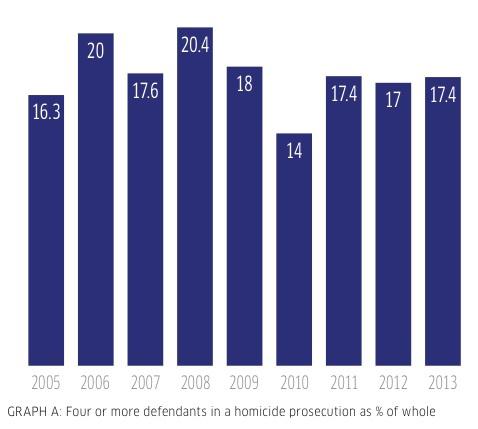
Prosecutions for homicides that involve four or more defendants in the same case ranged from 14% to 20.4% of all homicide prosecutions between 2005 and 2013. The peak was in 2008. The lowest rate was 14% of all prosecutions, in 2010.
Interestingly, the rate of four or more prosecutions rose slightly between 2012 and 2013, (from 17% to 17.4%). The rise comes over a period when new guidance produced by the DPP on prosecuting joint enterprise offences was introduced.
Two plus
Between 2005 and 2013 there were 4,590 prosecutions for homicide with two or more defendants. That was equivalent to 44% of all homicide prosecutions in those years.
In 2013, the most recent year for which we have data, 41% of all prosecutions for homicide involved two or more defendants.
The years with the highest rates for two or more defendants for homicide were in 2006 (47.33%) and 2008 (47.31%).
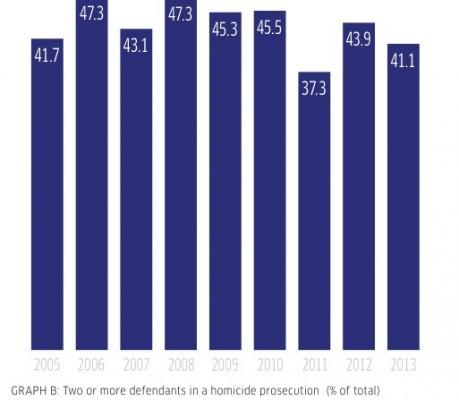
Convictions
Between 2005 and 2013, the average conviction rate for homicide – the number of people convicted of homicide out of the total number of people prosecuted – was 80.4% of all prosecutions.
However, the more defendants involved in the prosecution, the lesser the chances of securing a conviction. For two or more defendants the conviction rate dropped to 76.7% and for four or more defendants it was 73.3%.
In 2012 and 2013, 23% of the people charged in prosecutions involving four or more defendants ended in acquittals. These two years showed the highest acquittal rate out of the period studied – the average acquittal rate for four or more defendants being 19% over the period. (By comparison the total homicide acquittal rate was around 12% in those years.)
The data also showed that the more defendants involved in a homicide trial, the more likely it was that the CPS would ‘offer no evidence’ against at least one of the defendants, leading to the charge being dropped at trial stage. Between 2005 and 2013 the average was 4.3% of all trials for all homicides, and 5.2% for four or more defendants.
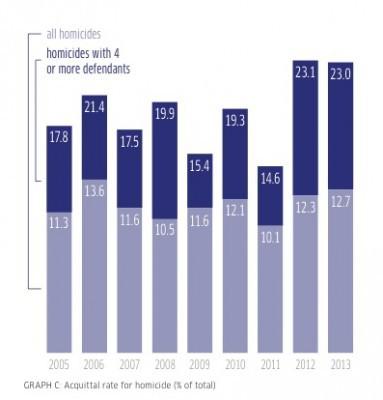
Inchoate offences
In 2007 the charging options open to the CPS were increased with the adoption of the Serious Crime Act. The Act introduced inchoate offences to cover those culpable by aiding or encouraging crimes.
Inchoate offences were introduced to replace the charge of incitement, and allow for someone to be convicted of encouraging or assisting an offence, even if the substantive act is not realised.
When it comes to charging a group of people for a single crime, these new charging offences can provide prosecutors with alternatives to using the joint enterprise doctrine, meaning secondary parties need not be charged with the principal offence, such as murder.
The Bureau’s data reveals the use of inchoate offence charges is on the rise. In 2009 there were 13 cases brought before the magistrates courts, in 2010 there were 47, in 2011 this rose to 121 and in 2012 there were 196 cases. There was then a slight drop off in 2013, where 143 inchoate charges were brought.
This is a minuscule fraction of all trials brought to the magistrates courts, but still represents an 11-fold increase between 2009 and 2013.
